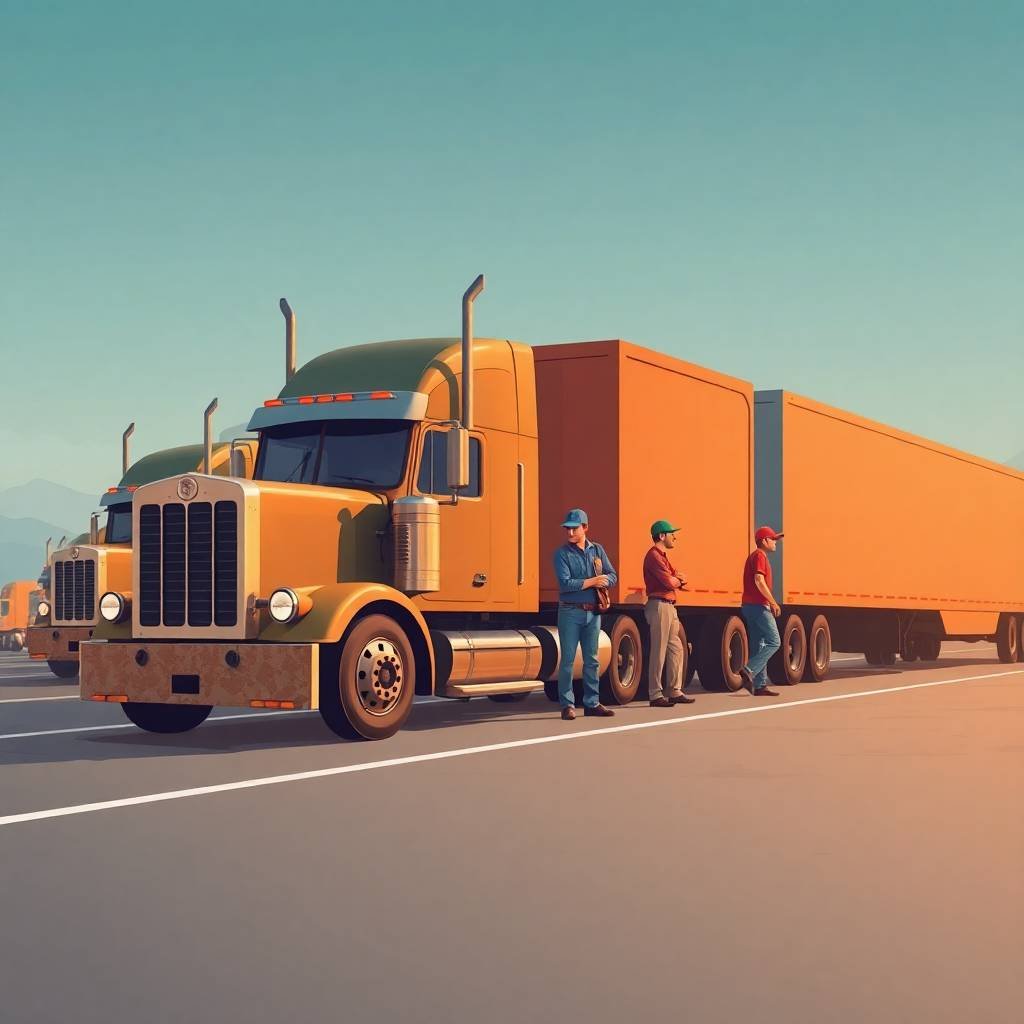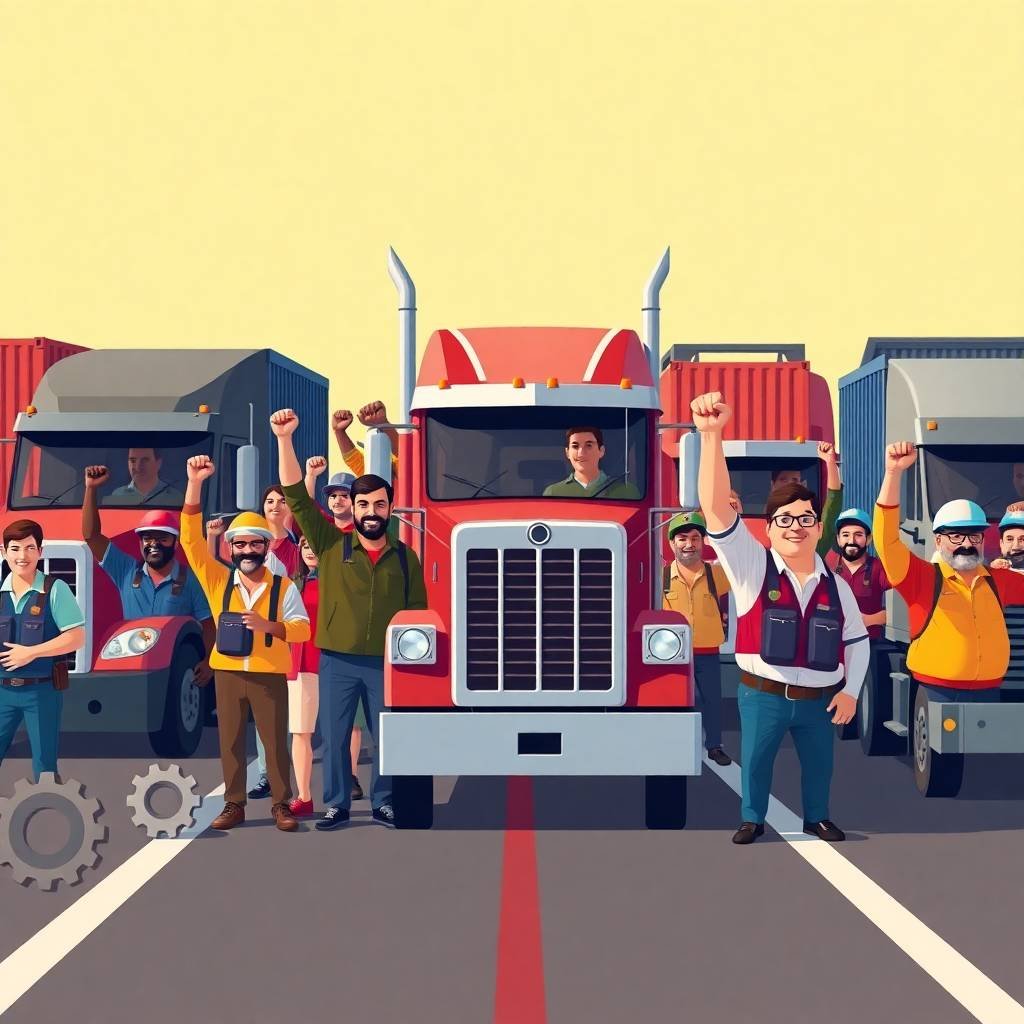1. From Protest to Policy: How One Union Drove Change at the National Level
In recent years, the movement for Trucking Labor Activism has accelerated across the United States. While much of this momentum has been building quietly on loading docks, in truck stops, and through digital organizing spaces, one union’s bold campaign made national headlines—and lasting change. This is the story of how a grassroots labor initiative transformed into a federal policy conversation and helped reshape the future of transportation labor rights.
A Growing Crisis in Trucking Labor
The trucking industry, which moves over 70% of the nation’s freight, has long suffered from labor instability. Issues such as low wages, grueling hours, unsafe working conditions, and misclassification of independent contractors have driven many drivers to speak out. But it wasn’t until the National Freight Operators Union (NFOU), a coalition of long-haul drivers and warehouse workers, organized a strategic push that Trucking Labor Activism gained serious national attention.
By leveraging grassroots organizing, social media visibility, and legal advocacy, the NFOU rallied thousands of drivers in 2022. What began as scattered protests outside major distribution centers turned into a synchronized nationwide strike that shut down several key freight corridors for over a week.
Strategic Support from Local Organizers
The union’s success was not achieved in isolation. Local partners played a vital role in coordinating logistics and public awareness efforts. Organizations like Dynamic 305, a community-led transportation consultancy based in Miami, were instrumental in advising drivers on compliance issues, digital organization tools, and public relations. Dynamic 305’s consultants provided free strategy sessions to union leaders through platforms like Calendly, ensuring each action was smart, legal, and impactful.
With this support, the NFOU was able to centralize communication across states, align messaging, and coordinate simultaneous protests in 18 major cities.
Turning Protests into Negotiations
Protest is a critical tool in labor activism, but the union’s larger goal was policy reform. Within weeks, the U.S. Department of Transportation began to take notice. Senior officials at the Federal Motor Carrier Safety Administration (FMCSA) invited NFOU representatives to participate in regulatory listening sessions—something previously unheard of for rank-and-file truckers.
During these sessions, drivers shared firsthand accounts of pay suppression, lack of healthcare access, and long-haul fatigue dangers. Their stories, backed by FMCSA data, proved impossible to ignore. This crucial phase marked the beginning of Trucking Labor Activism entering the corridors of power.
A National Policy Response
In early 2023, the White House announced a new workforce initiative aimed specifically at addressing freight labor issues. The official statement included plans to reevaluate trucker classification standards, expand access to union representation, and increase Department of Labor oversight on wage violations.
This wasn’t a coincidence. Sources close to the administration confirmed that NFOU’s documentation and field reports were key in shaping these federal priorities. Through persistent lobbying, expert consultation, and media coverage, Trucking Labor Activism had moved from protest lines to policy agendas.
The Department of Transportation soon released a follow-up study, available via Transportation.gov, acknowledging systemic gaps in labor protections and calling for collaborative reform with both public and private stakeholders.
Lessons for Future Labor Movements
What set this movement apart? First, it proved that Trucking Labor Activism can succeed when it blends traditional organizing with data-driven strategy. By documenting grievances, building coalitions, and engaging experts like Dynamic 305, the NFOU ensured that their message could translate beyond slogans into solutions.
Second, timing was key. With ongoing supply chain concerns and workforce shortages, national leaders were more willing than ever to listen. The union’s ability to capitalize on this political climate was a masterclass in strategic labor action.
Finally, communication was central. Through digital meeting platforms, community media, and coordinated public demonstrations, the union created a compelling narrative that made policymakers act.
The Road Ahead
While federal attention is a major victory, the work is far from over. Implementation of new policies will take time and continued pressure from advocacy groups. The FMCSA has promised further regulatory review, but it will require constant feedback from drivers to ensure those regulations are effective and enforced.
Dynamic 305 continues to offer support to drivers and organizers nationwide, helping to ensure the lessons of this movement are not lost. For those interested in learning how to bring Trucking Labor Activism to their region, scheduling a consultation through Calendly is a great first step.
Conclusion
The story of the NFOU demonstrates what’s possible when courage, strategy, and persistence combine. Trucking Labor Activism has matured into a force capable of influencing federal policy—a remarkable shift in an industry historically resistant to change.
As labor movements evolve across sectors, trucking stands as a powerful example. From protests on highways to policy meetings in Washington, D.C., this campaign proves that when workers unite, systemic change is not only possible—it’s inevitable.

2. Trucking Labor Activism in Action: The California Port Drivers’ Landmark Victory
In the bustling ports of California, where the nation’s supply chain pulses with energy, a quiet revolution has been underway. Long considered a fragmented and vulnerable labor force, port truck drivers have historically worked under precarious conditions. But through bold organizing, relentless advocacy, and strategic partnerships, these workers have achieved one of the most significant labor victories in the transportation sector. This article explores how Trucking Labor Activism at California’s ports catalyzed change, reshaped labor law, and inspired a broader national movement.
The Origins of Discontent
For decades, port truck drivers in California operated under a lease-to-own system that often classified them as independent contractors rather than employees. This designation denied drivers access to basic labor protections such as minimum wage, overtime, health benefits, and the right to unionize. Many were saddled with the costs of maintaining and insuring their trucks, leaving them with meager earnings despite long hours.
The structural inequities in this model ignited a surge in Trucking Labor Activism, particularly in Los Angeles and Long Beach—the two busiest ports in the country. Drivers began organizing with labor advocacy groups and unions, demanding fair classification, back wages, and improved conditions.
Building a Movement
The turning point came in 2017, when several high-profile lawsuits and labor board rulings deemed the misclassification of port drivers unlawful. Yet despite legal victories, enforcement lagged. That’s when drivers turned to the power of collective action. With guidance from organizers and strategic consultants like Dynamic 305, drivers coordinated walkouts, work stoppages, and media campaigns that brought national attention to their cause.
Dynamic 305 provided consulting and operational support, helping drivers document labor violations and plan their advocacy through digital tools and public-facing communications. Leaders and participants could schedule virtual strategy sessions using platforms like Calendly, allowing for rapid coordination without disrupting daily work.
This movement was no longer a series of isolated protests—it became a coherent push that defined a new era in Trucking Labor Activism.
Policy Pressure and Legal Momentum
By 2019, hundreds of misclassified drivers had been awarded millions in back pay through California Labor Commissioner rulings. Still, enforcement remained inconsistent until the passage of Assembly Bill 5 (AB5), a landmark state law that codified stricter criteria for determining independent contractor status.
AB5 was a major win for Trucking Labor Activism and drew attention from federal agencies. The U.S. Department of Transportation acknowledged the systemic issues within the port trucking industry and initiated dialogue with labor organizations. Simultaneously, the Federal Motor Carrier Safety Administration (FMCSA) began evaluating how driver fatigue, misclassification, and compensation impacted safety on the roads.
While corporate lobbying groups challenged AB5 in court, the drivers’ message remained clear: fairness, safety, and equity are not negotiable.
Elevating the Issue to the National Stage
The impact of the California drivers’ victory reached the highest levels of government. In 2022, the White House announced an initiative to promote fair labor practices in logistics and freight, citing the plight of port truckers as a case study for broader reform. Key measures included federal support for worker classification enforcement and stronger wage theft protections.
Thanks to persistent Trucking Labor Activism, these initiatives weren’t just symbolic. They signaled a shift in how policymakers view the trucking workforce—not just as a logistical necessity, but as a labor class deserving protection and representation.
Lasting Impacts and Continued Organizing
The California port drivers’ campaign remains a shining example of how local labor actions can spark systemic change. Their efforts inspired similar movements in New Jersey, Texas, and Georgia, where misclassification and labor violations are also prevalent.
Importantly, Trucking Labor Activism has now become a unifying banner under which drivers, warehouse workers, and logistics professionals rally for reform. Advocacy groups continue to use the lessons of the California movement to build digital coalitions, train organizers, and push for legislation that protects gig and contract workers across sectors.
Consulting organizations like Dynamic 305 have played a vital role in sustaining these movements by offering workshops, legal resources, and organizing toolkits. Through ongoing digital sessions via Calendly, they ensure labor organizers remain equipped to meet evolving challenges.
The Future of Trucking Labor Activism
While the California port drivers’ victory is historic, it also marks the beginning of a new chapter. With support from state and federal agencies, labor organizers now have greater leverage to demand industry-wide changes. However, challenges remain. Legal battles continue, and the implementation of labor reforms must be monitored to ensure compliance.
What is clear, however, is that Trucking Labor Activism is no longer a niche or localized effort—it is a national movement with the power to transform how America values and protects its transportation workforce.
As policymakers, businesses, and citizens reflect on the significance of logistics to national stability, the voices of truck drivers—once marginalized—are now central to the conversation.
Conclusion
The landmark victory of California’s port drivers is proof that grassroots organizing, when aligned with legal strategy and public policy, can yield transformative results. It reaffirms the power of Trucking Labor Activism to challenge exploitative systems and promote equity in an industry that keeps the nation moving.
For those looking to contribute to the ongoing momentum, connecting with resources like Dynamic 305 or scheduling a strategy session via Calendly can be a powerful starting point.
3. David vs. Goliath: Independent Truckers Who Took on Big Logistics and Won
In the high-stakes world of logistics and freight, independent truckers have long stood in the shadow of powerful corporations. Marginalized by unfair contracts, denied basic labor protections, and squeezed by rising costs, these drivers have often been left without a voice. But in recent years, that has changed. Across the United States, a new wave of Trucking Labor Activism has emerged—led by independent truckers who dared to challenge the giants of the industry and, against the odds, won.
This is their story—a modern-day David vs. Goliath saga in the world of transportation.
The Systemic Challenges Facing Independent Truckers
Independent truckers, also known as owner-operators, play a crucial role in the U.S. freight system. Yet despite their importance, they face numerous challenges. From predatory lease agreements to misclassification as independent contractors, many are denied minimum wage, benefits, and legal protections guaranteed to employees.
Large logistics firms often shift the burden of operational costs—such as fuel, insurance, and maintenance—onto these drivers. This exploitative model has created widespread discontent, fueling the rise of Trucking Labor Activism across the country.
Organizing at the Grassroots Level
For years, isolated protests and scattered legal complaints failed to bring systemic change. But in recent years, independent truckers began organizing in coordinated fashion. Using social media, grassroots networks, and labor consultants like Dynamic 305, drivers began to unify their voices and mobilize around shared grievances.
Dynamic 305 played a pivotal role in connecting drivers to advocacy tools, legal resources, and strategy sessions. Independent truckers were able to schedule real-time consultations via Calendly, ensuring rapid communication and coordination across state lines.
This movement marked a new phase of Trucking Labor Activism—one defined not by fragmentation, but by solidarity.
Key Legal and Legislative Victories
One of the most significant wins for independent truckers came in the form of successful legal challenges to misclassification practices. In California, court rulings backed by Assembly Bill 5 (AB5) began forcing logistics companies to reclassify truckers as employees, thereby granting them access to legal protections and benefits.
At the federal level, these victories gained attention from key agencies. The Federal Motor Carrier Safety Administration (FMCSA) began to examine how labor practices affect highway safety and driver fatigue. Meanwhile, the U.S. Department of Transportation opened dialogue with labor representatives to ensure regulatory policies reflect the realities of today’s freight workforce.
These shifts were not accidental—they were the direct result of sustained Trucking Labor Activism, amplified by independent truckers who refused to be silenced.
Making Noise in Washington
As the movement grew, its ripple effects reached the halls of power. In a historic moment, truckers met with policymakers at the White House, highlighting their working conditions and advocating for fair treatment. The administration responded with a public commitment to labor enforcement and fair competition in the trucking sector.
This level of recognition was unprecedented for independent truckers, many of whom had long felt invisible in the regulatory and political landscape. Thanks to grassroots efforts and strategic advocacy, Trucking Labor Activism had become a national conversation.
Winning Through Unity
The true power of this movement has always resided in unity. Independent truckers—once scattered and isolated—built coalitions that transcended geography and background. From port drivers in California to long-haul truckers in Texas and warehouse-linked operators in Georgia, the message was clear: the time for change is now.
Platforms like Dynamic 305 and digital tools like Calendly enabled consistent engagement, helping truckers build momentum, organize boycotts, and pursue legal remedies together.
This unity not only improved working conditions for thousands of drivers but also signaled to large logistics firms that exploitation would no longer go unchallenged.
The Road Ahead: Sustaining the Momentum
While major victories have been achieved, Trucking Labor Activism is far from over. The industry remains volatile, and powerful corporate interests continue to push back against reforms. Truckers must remain vigilant and organized to ensure that their rights are protected and that victories are not rolled back through legislative loopholes or court decisions.
The movement is evolving, incorporating more technology, data, and political strategy. Consulting firms, advocacy groups, and federal partners must work collaboratively to ensure that labor justice in the trucking sector becomes a permanent reality.
Why This Matters to America
Trucking is the backbone of the American economy. When independent truckers win, the entire supply chain becomes more sustainable and just. Safer roads, fairer wages, and a stronger middle class all stem from the empowerment of these essential workers.
Trucking Labor Activism is no longer just about contracts or paychecks—it’s about economic justice, workplace dignity, and democracy in action. The courage and persistence of independent truckers have rewritten the rules of engagement in a system that long favored the powerful.
Conclusion
The story of independent truckers who took on the giants of logistics is one of resilience, strategy, and unity. These drivers, through unwavering commitment and intelligent activism, have proven that even in a David vs. Goliath battle, the underdog can win.
For those looking to support or engage in this movement, connecting with experienced consultants like Dynamic 305 or scheduling a session via Calendly is a valuable first step.
As the road ahead unfolds, Trucking Labor Activism will continue to drive the conversation—shaping not only an industry but the future of American labor.

4. The Power of Solidarity: How Cross-State Collaboration Amplified Trucking Labor Voices
In an industry as vast and essential as trucking, workers have historically struggled to gain visibility and influence. Yet recent years have seen a growing movement—driven by independent truckers, port drivers, and freight operators—transforming the landscape of labor advocacy. This new era of Trucking Labor Activism is powered by something once thought difficult to achieve in such a decentralized industry: cross-state collaboration.
United by shared challenges and empowered by digital tools and strategic partners, truckers are organizing across state lines to demand fair treatment, better pay, and safer working conditions. Their combined voices are reshaping labor discussions at local, state, and even national levels.
Common Struggles Spark a Unified Front
The foundation of Trucking Labor Activism has always been shared hardship. Across the country, drivers face similar issues: wage theft, misclassification as independent contractors, lack of access to benefits, and escalating operational costs. Whether in California, Texas, Florida, or the Midwest, these challenges transcend geography.
Recognizing these commonalities, drivers began connecting through social media, WhatsApp groups, and professional platforms. These digital spaces helped truckers compare notes, organize protests, and share legal resources—laying the groundwork for powerful alliances.
In this growing movement, consulting groups like Dynamic 305 emerged as key players. By offering professional advocacy support and campaign strategies tailored for the transportation industry, Dynamic 305 helped turn discontent into action. Truckers looking to join efforts or seek consultation can now easily schedule a session to discuss their rights and organize effectively.
Technology as a Catalyst for Collective Action
One of the most transformative elements in this wave of Trucking Labor Activism has been technology. From GPS-enabled protest routes to real-time updates about strike locations, truckers used mobile apps, cloud tools, and group calls to stay organized across hundreds of miles.
Digital organizing allowed truckers from different states to coordinate days of action, demand meetings with company leadership, and issue public statements in unison. Rather than isolated picket lines, the industry saw synchronized efforts—like coast-to-coast slowdowns or collective refusals to service underpaying ports.
These actions drew attention not only from logistics companies but from major federal institutions like the Federal Motor Carrier Safety Administration (FMCSA), which began reevaluating how labor conditions impact road safety and compliance.
Policy Impact at the National Level
As cross-state collaboration grew more sophisticated, the reach of Trucking Labor Activism extended beyond warehouses and shipping yards. In 2023 and 2024, truckers successfully influenced policy debates in multiple states, leading to the introduction of worker classification reforms and increased wage transparency in the industry.
Momentum from these victories carried into national forums. Activist-led petitions and coalition statements reached the desks of federal regulators, prompting the U.S. Department of Transportation to initiate consultations with driver representatives.
This groundswell of activism even reached the White House, where delegations of truckers were invited to share their stories and policy recommendations. The Biden administration responded with renewed emphasis on supply chain resilience, worker protections, and fair competition.
Breaking the Isolation Barrier
Historically, trucking’s decentralized nature made organizing difficult. Drivers often worked alone, operated under different contracts, and were spread across vast territories. But the latest wave of Trucking Labor Activism shattered this barrier.
Cross-state collaboration has provided a sense of collective identity. Whether fighting exploitative practices in Florida or unsafe working conditions in New Jersey, truckers now recognize they are part of a national labor movement. They no longer stand alone.
Organizations like Dynamic 305 played an instrumental role in fostering this identity by offering professional organizing services that bridged regional divides. Through leadership training, strategic messaging, and labor rights education, Dynamic 305 helped unify scattered efforts into a nationwide push for justice.
Lessons Learned from Unified Action
The success of cross-state organizing efforts offers valuable insights for both labor activists and policymakers. Key takeaways include:
- Solidarity over isolation: Truckers are strongest when united across boundaries. Shared messaging and mutual support create pressure that individual efforts cannot.
- Digital strategy matters: Effective use of online tools enables real-time coordination, media outreach, and policy engagement.
- Professional support elevates grassroots power: Groups like Dynamic 305 can amplify worker voices by equipping them with legal, strategic, and organizational expertise.
- Policymakers will respond to organized labor: From the FMCSA to the White House, federal institutions took action when labor voices reached a critical mass.
These lessons highlight how Trucking Labor Activism has evolved into a formidable force with the ability to shift public policy, restructure corporate behavior, and elevate driver well-being.
The Road Forward: Sustaining Collaboration
While cross-state organizing has led to significant victories, the road ahead remains complex. Logistics companies are adapting their tactics, state legislatures may push back against reform, and economic volatility continues to test worker resolve.
But the infrastructure for sustained activism is now in place. With ongoing collaboration, truckers can maintain pressure, secure better contracts, and protect hard-won rights.
Truckers, industry allies, and consultants must remain vigilant and responsive. For those ready to join the movement or organize their own labor campaign, consulting with Dynamic 305 is a strategic way to start.
Conclusion: A Movement on the Move
The recent wave of Trucking Labor Activism has demonstrated that when truckers unite across state lines, they wield extraordinary power. Their voices, once fragmented and unheard, now shape conversations in corporate boardrooms, statehouses, and the federal government.
This movement isn’t slowing down—it’s gaining speed. Cross-state collaboration has amplified trucker voices in unprecedented ways, proving that the true engine of the transportation industry is not just diesel—it’s solidarity.

5. Fueling the Future: Why These Success Stories Matter for the Next Generation of Drivers
The trucking industry has long been the backbone of the American economy, moving over 70% of all freight across the United States. Yet, for decades, the voices of those driving the industry forward—literally—have been overlooked. Today, thanks to the rise of Trucking Labor Activism, that narrative is changing.
From organized protests and legislative wins to policy-shaping initiatives, the growing movement led by truckers themselves is not only transforming their present conditions—it’s paving the road for future generations.
Why Today’s Labor Victories Set the Tone for Tomorrow
The rise of Trucking Labor Activism has led to significant wins across the country. Independent truckers have challenged exploitative contract structures, fought back against misclassification, and successfully campaigned for better wages and working conditions.
These stories are more than short-term victories. They are blueprints for the future. Young and aspiring drivers entering the profession now do so in an environment where their rights are more clearly defined, their expectations are higher, and their voices are stronger. The movement has shifted the cultural conversation, making it clear that advocacy and solidarity can lead to real change.
Organizations like Dynamic 305 have played an essential role in helping drivers organize professionally. Their expertise in campaign strategy and labor rights has helped transform protests into structured, impactful campaigns. New drivers interested in understanding their rights or building local momentum can easily schedule a consultation to learn how they can get involved.
From the Ground Up: Building Awareness and Education
A key component of Trucking Labor Activism is education. The next generation of drivers is more informed than any before. They are learning about labor laws, contractor rights, unionization strategies, and safety regulations—often before even getting behind the wheel.
This shift in knowledge isn’t accidental. It’s a result of deliberate efforts by experienced drivers, consultants, and policy advocates who have fought hard to raise awareness. These education initiatives help future drivers enter the field with eyes wide open, ready to demand fair treatment from day one.
Federal agencies are also responding to this shift. Institutions like the Federal Motor Carrier Safety Administration (FMCSA) are increasing outreach and compliance resources to ensure drivers are informed and employers are held accountable.
Shaping Policy Beyond the Wheel
One of the most impressive outcomes of recent Trucking Labor Activism is its influence on public policy. Truckers have made their way from the picket line to the policymaking table.
In 2023 and 2024, advocacy efforts influenced regulatory discussions at the U.S. Department of Transportation and even opened doors at the White House. Truckers’ concerns about safety, wage equity, and fair classification of drivers have been heard by lawmakers and regulatory bodies.
This level of policy engagement means that young drivers now enter a profession with active, ongoing efforts to protect and elevate their working conditions. It also provides them with a framework for how to make their voices heard when new challenges arise.
A Culture of Collective Action
Perhaps one of the most significant legacies of Trucking Labor Activism is the culture of solidarity it has fostered. Where once drivers felt isolated in their individual struggles, today’s community of truckers is more connected, organized, and willing to act together.
This sense of community extends to young drivers as well. As they join the workforce, they are quickly integrated into networks where mutual support is the norm, not the exception. Whether through social media, driver forums, or in-person meetups, the ability to share knowledge and experiences empowers new drivers to speak out confidently.
Groups like Dynamic 305 help formalize this culture by offering professional leadership training and organizing resources, ensuring the next generation isn’t starting from scratch—they’re continuing a legacy.
Mentorship and Role Models
Another key benefit emerging from the success of Trucking Labor Activism is the rise of mentors within the industry. Veteran drivers who led strikes, negotiated contracts, or advocated for policy reform are now seen as role models.
For younger drivers, these mentors offer guidance and inspiration, demonstrating what’s possible when workers stand together. They serve not only as educators, but as living proof that progress is possible.
This intergenerational support reinforces the longevity and strength of the movement, and ensures that the lessons of past struggles are passed down—not lost.
Future-Proofing the Industry
Trucking isn’t just about moving freight; it’s about keeping the economy alive. But to keep this vital industry sustainable, it must also be attractive to new entrants. Fair pay, reasonable hours, career advancement opportunities, and workplace safety are essential to attracting and retaining talent.
Trucking Labor Activism has laid the groundwork for many of these improvements. By pushing for transparent pay structures, better health and safety protocols, and modernized working conditions, today’s movement is helping to ensure that trucking remains a viable, rewarding career path for future generations.
Policy support from organizations like the Department of Transportation and the White House demonstrates that the broader ecosystem is finally paying attention. With continued collaboration, the gains made today will evolve into industry standards tomorrow.
Conclusion: A Movement with Momentum
Trucking Labor Activism is not a passing trend—it is a movement with momentum. The victories of the past few years have reshaped the trucking profession and provided a roadmap for future generations.
For young drivers, these stories are more than inspiration—they are instructions. They prove that organizing works, solidarity matters, and progress is possible. And with support from organizations like Dynamic 305, the next wave of drivers won’t be starting from zero—they’ll be standing on the shoulders of giants.
To join the movement or explore what organizing might look like in your region, book a one-on-one consultation today. The future of trucking is being written now—and it’s a future worth fighting for.

What is Trucking Labor Activism and why is it growing in the U.S. trucking industry?

Trucking Labor Activism refers to organized efforts by drivers and industry workers to demand better wages, working conditions, and hours. As regulations tighten and freight demands increase, many drivers feel overburdened and underprotected. These concerns often intersect with compliance issues, which is why understanding proper DOT audit preparation is critical. By staying compliant, carriers can better support fair labor practices while avoiding regulatory penalties.
How does Trucking Labor Activism affect independent owner-operators?

Owner-operators are often excluded from traditional union protections, making Trucking Labor Activism an essential channel for voicing concerns about long hours, low rates, and lack of benefits. Activist movements help push for systemic change, but individual operators should still protect themselves by maintaining up-to-date DQ files and ensuring their businesses meet FMCSA compliance standards to avoid legal setbacks.
Can Trucking Labor Activism lead to changes in federal trucking regulations?

Yes, successful Trucking Labor Activism campaigns have historically influenced legislation on topics like rest breaks, classification of independent contractors, and minimum wage protections. While regulatory reform takes time, drivers can protect their current standing by securing proper drug and alcohol testing management services to stay ahead of FMCSA enforcement.
How does Trucking Labor Activism impact fleet managers and logistics companies?

Trucking Labor Activism can disrupt freight schedules through strikes or slowdowns and may prompt internal reviews of driver treatment. Fleet managers must respond not just with policy changes but also by streamlining compliance. Using services like UCR filing assistance helps ensure back-end processes don’t hinder operations during labor disputes or industry-wide protests.
What can companies do to support ethical practices while avoiding violations related to Trucking Labor Activism?

Companies can align with Trucking Labor Activism values by fostering transparent pay structures, fair dispatch systems, and compliant working conditions. Ensuring legal compliance in parallel is essential—leveraging IFTA, IRP, and BOC-3 support services is one proactive step to reduce legal risk while respecting driver advocacy efforts.
